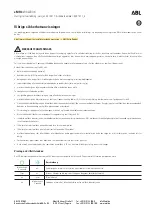
headline bars
continuation tabs
notes
warnings
7
headline bars
con
tinua
tion tabs
not
es
w
ar
nings
headline bars
continuation tabs
notes
warnings
headline bars
continuation tabs
notes
warnings
headline bars
continuation tabs
notes
warnings
CONNECTING Y
OUR
BA
TTER
Y
WARNING!
A spark near a battery may cause a battery explosion!
NOTE: a marine battery installed in a boat must be removed and charged
on shore. To charge it onboard requires equipment specially designed for
marine use.
FPO
BATTERY IN VEHICLE
(NEGATIVE GROUNDED)
1.
Before connecting and disconnecting the DC
output clamps, remove the AC plug from the
electrical outlet.
2.
Check polarity of battery posts.
A positive (POS, P, +) battery post usually has
a larger diameter than a negative (NEG, N, -)
battery post.
3.
Connect the positive (red) clip from the
battery charger to the positive (POS, P, +)
ungrounded post of battery.
4.
Connect the negative (black) clip to vehicle
chassis (must be a heavy gauge metal part of
the frame) or engine block away from battery.
DO NOT connect clip to carburetor, fuel lines,
or sheet-metal body parts.
5.
Connect charger AC supply cord to electric
outlet. (Reverse process to remove charger.)
BATTERY IN VEHICLE
(POSITIVE GROUNDED)
1.
Before connecting and disconnecting the DC
output clamps, remove the AC plug from the
electrical outlet.
2.
Connect the negative (black) clip from the
battery charger to the negative (NEG, N, -)
ungrounded post of battery.
3.
Connect the positive (red) clip to vehicle
chassis (must be a heavy gauge metal part of
the frame) or engine block away from battery.
DO NOT connect clip to carburetor, fuel lines,
or sheet-metal body parts.
4.
Connect charger AC supply cord to electric
outlet. (Reverse process to remove charger.)
NOTE:
NEVER allow the DC output clamps to touch each other. This may cause a spark.
Remove the AC plug from the electrical outlet before connecting and disconnecting the DC output clamps.
To reduce the risk of a spark near battery:
• Position AC and DC cords to reduce the risk of damage by hood, door, or moving engine part.
• Stay clear of fan blades, pulleys, and other parts that can cause injury.
• Check polarity of battery posts. A positive (POS, P, +) battery post usually has a larger
diam eter than a negative (NEG, N, -) battery post.
®
MD








































